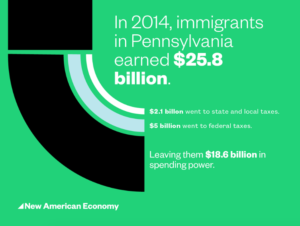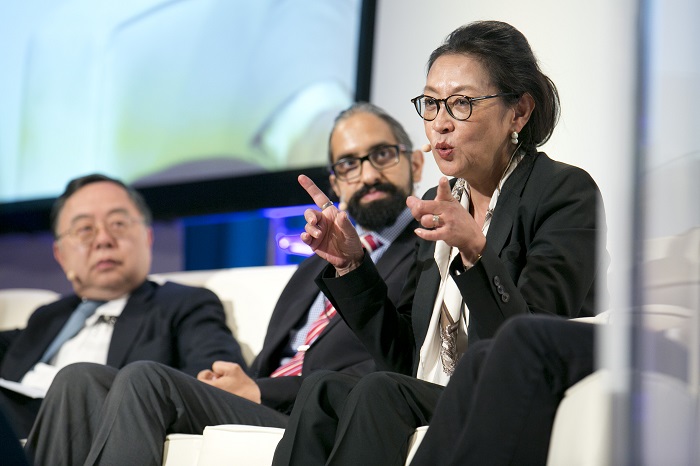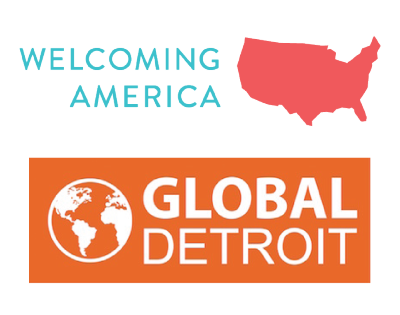50 State Data Report Affirms Immigration’s Impact on Economy
 On August 3, Peter Gonzales, the President and CEO of the Welcoming Center for New Pennsylvanians led one of 62 events in all 50 states to talk about immigration’s impact on local economies. Peter joined the Greater Philadelphia Chamber of Commerce, Pennsylvania Department of State Secretary Pedro A. Cortés, and other community leaders in Philadelphia to unveil the new 50 state economic data report from our friends at the New American Economy (NAE).
On August 3, Peter Gonzales, the President and CEO of the Welcoming Center for New Pennsylvanians led one of 62 events in all 50 states to talk about immigration’s impact on local economies. Peter joined the Greater Philadelphia Chamber of Commerce, Pennsylvania Department of State Secretary Pedro A. Cortés, and other community leaders in Philadelphia to unveil the new 50 state economic data report from our friends at the New American Economy (NAE).
“Regions that lead in the 21st Century must intentionally attract diverse people,” Peter noted, “Becoming a more welcoming place for immigrants provides our region with a competitive leg up on the competition.” Rob Wonderling, President & CEO of the Greater Philadelphia Chamber of Commerce added that “supporting immigrant population growth and accelerating immigrant integration will continue to attract and retain successful business owners and workers from around the globe to Greater Philadelphia, further strengthening our region’s diverse and vibrant economy.”
The Contributions of New Americans in Pennsylvania, as the NAE data report for Pennsylvania is named, shows that immigrants make up 6.4 percent of Pennsylvania’s population and contributed more than $7.1 billion in taxes in 2014. That same year, their total income was $25.8 billion, or 7.2 percent of all earnings in the state.
Similar data was released for all 50 states and WE Global members in Michigan, Missouri, and Ohio either hosted press conferences or took to the airwaves to discuss the new data. Global Cleveland hosted a press conference and the Michigan Office for New Americans and St. Louis Mosaic were both interviewed on local public radio. WE Global members helped NAE to spread the state reports, highlighting the tax contributions, strong labor force participation, high entrepreneurship rates, and tremendous educational attainment levels of immigrants across the Rust Belt. Moreover, immigrants have served as the foundation for population growth (or as a strong countervailing force against population decline) for most Rust Belt cities, metros, and states.
The New American Economy is a national research and advocacy group originally launched by former New York Mayor and businessman Michael Bloomberg and brings together more than 500 Republican, Democratic, and Independent mayors and business leaders who support sensible immigration reforms that will help create jobs for Americans today. Nationally, the reports indicate that immigrant households earned $1.25 trillion in 2014 and paid $223.5 billion in federal taxes, $104.6 billion in state and local levies, and $123.7 billion in Social Security and $32.9 billion in Medicare payments.
August 3’s data release by NAE represents one of the most comprehensive and easy to access sources of information on a state-by-state basis. It reiterates and updates a number of compelling statistics that strongly suggest that immigrants create jobs and that they greatly enhance the economic well-being of U.S.-born residents in their local economies and neighborhoods.
WE Global members have been pioneers at integrating these facts and designing innovative local and regional polices to welcome immigrants and refugees, integrate them into local economic development strategies and programs, and build more vibrant communities. If you want to learn more about the nearly two dozen Rust Belt communities that are setting the standard for the nation’s most innovative local immigrant economic development policies, please join Peter Gonzales and the Welcoming Center for New Pennsylvanians as they host the 2016 WE Convening on October 19-21. The Convening is an opportunity to discuss the latest trends, practices, and innovations to help Rust Belt cities and other communities develop and hone strategies to build growth economies and revitalize neighborhoods through immigrant integration.


